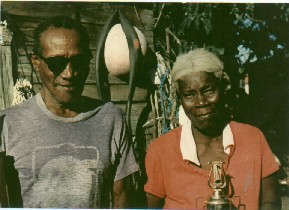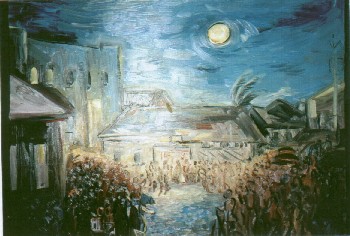
BELURIA - Nineth Night - Pen Cayetano 1992
oil on canvas, 140 x 200 cm,
courtesy of Atlantic Bank Ltd, Belize
Click on picture to see a larger version.
Peace be with you, ladies and gentlemen. My topic today will be on Punta Rock and its achievement in Belize and Central America. This talk is from an artist's perspective.
Punta Rock is the creation of myself, Pen Cayetano, and it started in the year of 1978 in the artist's Studio at 5 Moho Road in Dangriga, Belize C.A. Around that time and before Isabel Flores, Machete, Walta, Coyboy Flores, Gabaga, Nabour and more were in charge of cultural music, not to forget the female singers like Mudu, Tugusu Kutu, (Sarah Webu) and many more. Cultural music like the Punta were only performed at a Beluria (nineth night) or celebrations.

BELURIA - Nineth Night - Pen Cayetano 1992
oil on canvas, 140 x 200 cm,
courtesy of Atlantic Bank Ltd, Belize
Click on picture to see a larger version.
A big change came with the migration of many Garinagu to the USA to achieve higher education, which resulted also in leaving the children in the care of grandmothers. Only a few kids were able to learn to speak the native Garifuna and that affected the youth in that way not to understand the meaning of the traditional songs from the old folks. So during celebration time around the 19th November when the Garinagu celebrate their first landing to Belize, I remember this following incident. It was the 13 November 1978 when the Garinagu gave their annual tribute to T.V. Ramos, their cultural leader, the two generations clashed together. Isabel Flores was leading a group with his drummers and singers when some young folks started to sing vulgar songs in Garifuna. Nobody could stop them so the old people with Isabel Flores and Mr. Hilberto took their drums and left the youth doing their own thing. From then the youth were banned to join the other celebrations.

Masterdrummer Isabel Flores and his wife Josi from Dangriga
Click on picture to see a larger version.
For me it was sad to watch what had happened, but at the same time it opened my eyes and mind that something had to be done for the younger generation. Instinctively I knew that the Garinagu culture had reached the time for a change. I studied the old songs and started to write my own songs and played the Garifuna drums and also discovered how to use different sizes of turtle shells as a percussion instrument. Usually after I worked on my paintings during the day, I began making music in the late afternoon. First I practised all by myself until later some friends joined in. We did only cultural music because I didn’t tolerate imitating of hit records.
My first song was entitled “Garifuna”, but nobody knew it until I made “Miusunali Bou” and “Suha Wau”. Many brothers passed by my studio: Poots, Payne, Stump and also teachers, policemen and doctors. A lot of interested people came to check me out.
Around that time there was no television in Dangriga and no drugs like cocaine and crack. There was time to talk, time to create, time to make music.
It was not until 1979-80 when the Turtle Shell Band was founded. Mohobob returned from Guatemala and myself and Myme started the first formation. Then came Faltas, Higgins and Jeep and the six of us practised daily on the veranda of Pen’s Art Studio on 5 Moho Road the new sound, when I finally got the idea of quickening the traditional Punta rhythm, adding the electric guitar and the turtleshells to it and called the music Punta Rock and named the group “The Turtle Shell Band”.
Originality and culture were our basic principles. After doing rehearsals for quite some time, we began to do the so called roadblocks. Our first roadblock we had in front of the Star Club on St. Vincent Street. It was very much appreciated by the Dangrigans. There was also a hat collection by the late Gervis. Around that time the band members were: Mohobob (lead Turtle shell), Myme (Garifuna drums), Higgins (small shells), Jeep (chaka), Faltas made his own drum ,the “cricket snare”, and myself on the guitar and leader. The Turtle Shell Band was following my instructions and idea and message. I bought all the instruments we needed from income I had from my paintings' sales and soon I also got a second hand amplifier and a few microphones.

Turtle Shell Band jamming at Pen's Art Studio at 5 Moho Road 1991
Click on picture to see a larger version.
Finally the Turtle Shell Band did a roadblock at 5.30 p.m. every Friday on Commerce or St. Vincent Street in front of the Ten Store. The owner Mrs. Anselma supported us by giving us drinks, food and sometimes a little money. We usually performed until 9 p.m. and we gathered a nice crowd, because there was also the buses from Belize City arriving. One day we were invited by Mrs “Din” Guerro, the owner of the Eden Rose Club, to perform at her club. That was our first night jamming for a dance and she did a hat collection for us. It started cool and easy with people checking the new sound until later in the night the crowd went wild and began to really puntarock. The song “Goubana” was one of the favourite beats at that time and from then on Punta Rock had a price. We started to collect by the door 1$ for gents and 50 cents for ladies. First we played only on Fridays, but after a short while we performed on Saturday and Sunday.

"Road Block with Turtle Shell Band at Ten Store Dangriga", Pen Cayetano, 2001
oil on canvas, 50 x 60 cm,
courtesy of Alejandro Ramos, Venezeula
Click on picture to see a larger version.
So the Turtle Shell Band played in Dangriga for quite a while until on 28 July, 1982, I decided to take a step out of Dangriga. That Friday we took the 6.00 a.m. bus to Belmopan where we did our show at the Market Place. The people were enthusiastic about the music and the new sound. So eventually we met more friends and got support and assistance. A hat collection gave us that time about $75. At 1.OO p.m. we got on another bus to Belize City. Nobody had heard about the Turtle Shell Band from Dangriga as yet. We were looking for a place to play until late in the afternoon between 6.30 and 7.00 p.m. the group met Romel Perdomo and he invited us to jam at his Club “Bonfire”. Our pay was about $50, and food and drinks for the night. The next day, the Saturday, became to be a historical day for the Turtle Shell Band. After we woke up at 7.00 a.m. at Norman Sutherland’s house we decided to go to the Central Park to do our show. We had to pay for the electric connections for our musical show. Our first song was “Think about life”. People started to gather and the crowd became thick and they listening to our life music - to our message. This was one of the gorgeous moments in my life. With the hit “Uwala Uwala Busiganu” (Don’t be ashamed of your culture) the crowd got to a climax . Then it started to rain and the people began to scatter. It happened that we continued to play and created a song on the spot “Huya ma Huya ma yah Uburugu Balice”( It’s raining in Belize). After the rain stopped we were invited from Radio Belize for a live recording in Belize’s only studio at that time and we were more than glad to be welcomed and knew that Punta Rock was on his way up.
The Turtle Shell Band took the Punta Rock out of Belize and spread the message across the Caribbean, Mexico and the USA. International recognition they gained in 1983 at the New Orleans Jazz Festival. The songs were written mostly in Garifuna language talking about the history, calling for pride and awareness of the culture and not losing it — what UWALA BUSIGANU means. Some songs are referring to the hardship of the Garifuna and their experience as well as love, joy and happiness. I, Pen Cayetano, popularly known as the “King of Punta Rock”, achieved numerous awards and citations in music and art.
Various bands all over Belize and Honduras started to pick up the Punta Rock sound and from then on the music took a life of its own.
Belizeans like most Caribbean people who have been devalued by centuries of colonial suppression, tend not to appreciate their own roots and culture. Even though I’m recognised as one of Belize’s most innovative artist and musician, I found it necessary to move to Germany in 1990. In my new home I taught my kids in art and music and formed the family band “The Cayetanos” in 1998 and started a new generation of Punta Rock music. I have produced the following musical recordings, “In Mi Country” (1994), “Sweet Africa” (1996), “Punta Rock” (2000), “The Beginning” (2001), Pen Cayetano and Mohobub Flores “Best of Punta Rock” (2002), Pen Cayetano “In Mi Country” (2003). (For more details, see my website: www.cayetano.de.)
It is a fact that Punta Rock is a force in the process of developing cultural awareness and strengthening national identity in Belize for all ethnic groups.

"The original Turtle Shell Band ", Pen Cayetano, 1992
oil on canvas 60 x 85 cm
The roots of Punta Rock music 1981 in Dangriga, Belize: from left to right, Peter Jeep Lewis, Myme Martinetz, Faltas Nolberto, Pen Cayetano, Bernard Higgins, Mohobub Flores
Click on picture to see a larger version.

Click on picture to see a larger version.
© Pen Cayetano, 2003.
 HTML last revised 20th March, 2003.
HTML last revised 20th March, 2003.
Return to Conference Papers.